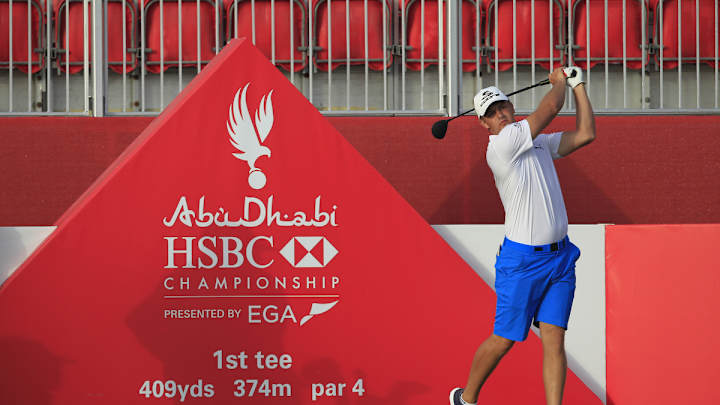European Tour’s big Mideast gamble pays off

European Tour chief executive Keith Pelley receives a lot of plaudits for his innovative approach. Predecessor Ken Schofield was way ahead of him. If not for the Scot, the European Tour probably wouldn’t be starting a lucrative three-week swing in the Middle East this week.
Pelley has been lauded for being progressive: allowing players to wear shorts, play music on practice ranges and adopting new competition formats such as the two-man national teams in GolfSixes, plus a social-media drive that has attracted millions of hits. Schofield, the CEO from 1975 to 2004, took a gamble in 1989 that brings millions of dollars to the tour.

This week, European Tour players will embark on a $14 million, three-tournament Middle East Swing on the Arabian Peninsula, starting with the $7 million Abu Dhabi HSBC Championship. In the following two weeks, they will play the Omega Dubai Desert Classic and the Saudi International. In late February, the tour will return to the region to play the Oman Open and then the Commercial Bank Qatar Masters before ending its 2019-20 schedule in November in the desert with the $8 million DP World Tour Championship, Dubai. That’s six tournaments and $25.5 million in prize money, all because of a speculative punt Schofield took 31 years ago.
The Tour’s Middle East Swing comes amidst tensions between the United States and Iran. The U.S. men’s soccer team pulled out of a planned training camp in Qatar as a result. No way that the European Tour was going to follow suit. The tour is used to playing in the Middle East when tensions are high. Rest assured that the tour will have been given private reassurances from the ruling sheikhs that tournaments will be unaffected.
Popular sentiment pegs the 1989 Karl Litten Desert Classic in Dubai as the European Tour’s first venture outside of Continental Europe. It wasn’t. Schofield broke new ground beyond Europe with the 1982 Tunisian Open.
The Tunisian Open disappeared after the 1985 edition. However, Schofield’s Dubai investment paid off big-time. It’s like buying a lottery ticket on a whim and hitting the jackpot.
“When I was approached about holding an event in Dubai, I just thought, Why not?” Schofield said. “I had nothing to lose. Did I think back then the Middle East would become so important to the tour? No. My job was simple: to attract sponsors and provide playing opportunities for European Tour members.”
He certainly did that, and grew the European Tour schedule exponentially. Qatar followed in 1998 with the Qatar Masters. Abu Dhabi came onboard in 2006. Oman debuted in 2018, followed by the Saudi International last year. Dubai began staging the tour’s season finale in 2009.
England’s Mark Roe missed the inaugural Desert Classic in 1989, but he played the following year and made it a regular stop until his retirement in 2006.
“The Middle East Swing has been huge for the tour,” said Roe, a three-time winner on the tour who is a TV commentator for Sky Sports and sits on the European Tour board. “Three huge tournaments in January with quality fields was unheard of when I started playing. We had to wait until April when I began my career [in 1985].
The Middle East Swing doesn’t just give rank-and-file players more playing opportunities. European Tour stars can play their home circuit before the dead-zone period from February to May, when purses are low. Ireland’s Shane Lowry, the reigning Open champion and the defending champion this week in Abu Dhabi, will join England’s Tommy Fleetwood, Matt Fitzpatrick, Ian Poulter, Matt Wallace and Danny Willett, Spain’s Sergio Garcia and Sweden’s Henrik Stenson in playing all or part of the Middle East Swing before heading to the U.S. for the PGA Tour. Some of these guys won’t return to the European Tour until the $7 million Irish Open in late May.
“We know the schedule isn’t great after February, so it’s a chance to play the European Tour early in the year and earn Race to Dubai points,” said Fleetwood, who won at Abu Dhabi in 2017 and 2018.
Mark James pocketed £41,660 as the inaugural Desert Classic winner, from a total prize fund of £251,708. The 2020 Abu Dhabi winner will earn $1.14 million.
This week’s field includes some of the top Americans, notably World No. 1 Brooks Koepka, No. 7 Patrick Cantlay and No. 16 Bryson DeChambeau. Koepka also will return to the Saudi International, with countrymen Phil Mickelson and defending champion Dustin Johnson.
Don’t think that these guys are traveling to the Middle East to sample the culture. They, and Europe’s top stars, will be there to rake in large wads of cash. Koepka, a four-time major champion, reportedly will be paid a seven-figure appearance fee. Cantlay and DeChambeau, like Garcia, Poulter, Lowry and Fleetwood, won’t make as much for showing up, but they’ll be handsomely rewarded before they’ve hit a shot. Koepka and Johnson reportedly were paid $1 million each to compete in Abu Dhabi last year, and a further $1.5 million apiece to play in Saudi Arabia.
Appearance money, which is prohibited by the PGA Tour, was the offshoot of Schofield’s 1989 gamble. Golf’s marquee names benefit from Arab States competing against one another. In the early days, Seve Ballesteros, Nick Faldo, Greg Norman, Fred Couples and others cashed in. Tiger Woods followed suit with seven-digit asking prices. He reportedly was offered $3 million to play in Saudi Arabia last year, and he turned down a similar fee this year.
Many have wondered why Koepka and Co. insist on fulfilling their Middle East commitments when safety in the region is so precarious because of tensions with Iran. Firstly, these guys have signed contracts. Secondly, they’ll each have security guards in tow as part of those contracts.
Hmm, I wonder whether Schofield foresaw so much money going to players when he bought that lottery ticket in 1989?
